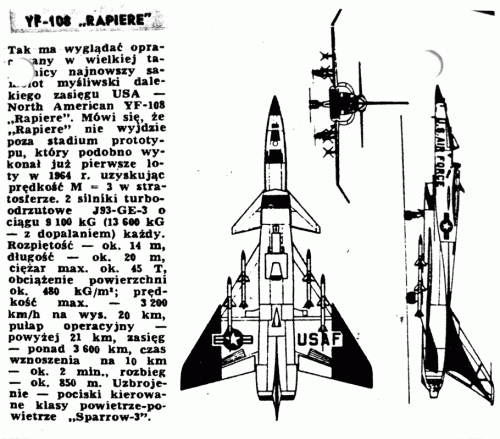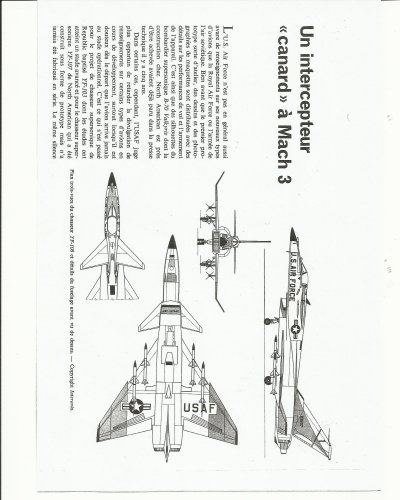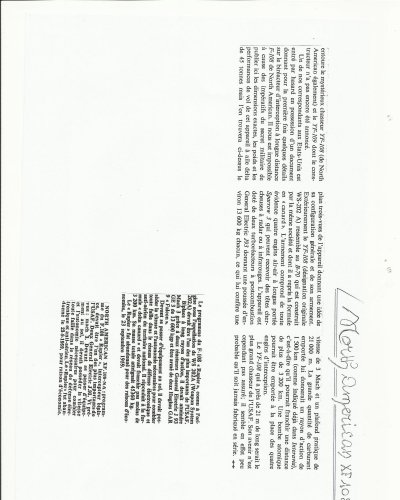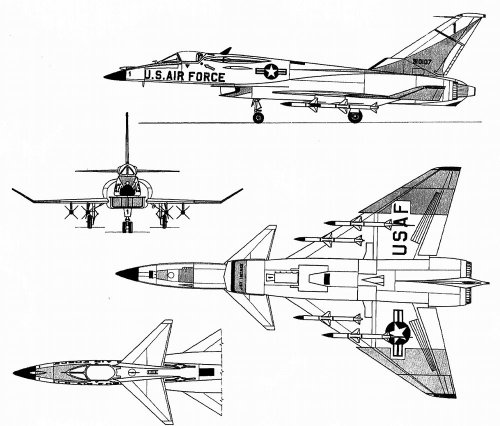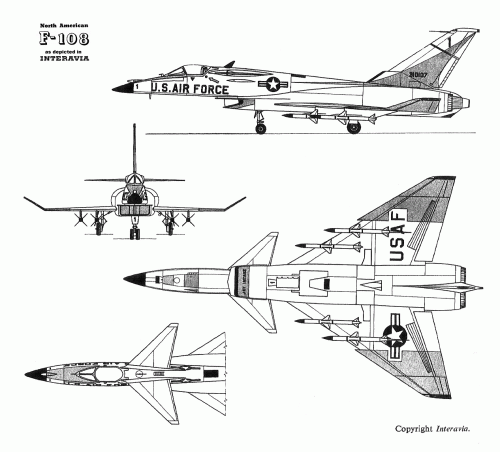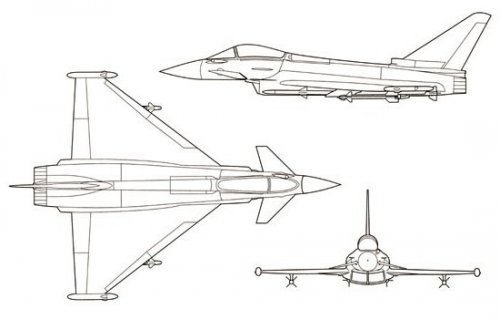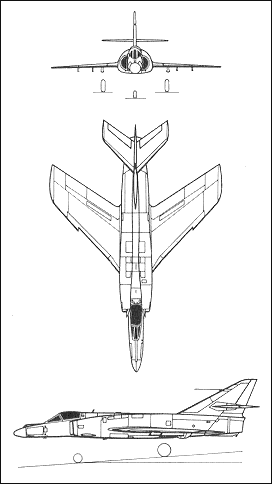You are using an out of date browser. It may not display this or other websites correctly.
You should upgrade or use an alternative browser.
You should upgrade or use an alternative browser.
North American XF-108 (F-108) Rapier
- Thread starter sferrin
- Start date
- Joined
- 27 December 2005
- Messages
- 17,572
- Reaction score
- 25,017
Isn't it a rubbish pic of the XB-70
:'(
overscan said:Isn't it a rubbish pic of the XB-70
No, it's a top view of the ITC Model Craft "F-108 Rapier."

http://www.fantastic-plastic.com/ITCF-108RAPIERPAGE.htm
Colonial-Marine
UAVs are now friend, drones are the real enemy.
- Joined
- 5 October 2009
- Messages
- 1,460
- Reaction score
- 1,288
Regarding the armament of the F-108, many sources I have read mention 4 20mm cannon, and 108 rockets, as well as the capability to carry up to 5000 lbs of bombs. Were these just different configurations studied, or the initial requirements from the earlier days of the program?
Also, were any studies done regarding the reconissance variants? Would such a development mean the Lockheed A-12 and SR-71 would never enter service?
Also, were any studies done regarding the reconissance variants? Would such a development mean the Lockheed A-12 and SR-71 would never enter service?
- Joined
- 14 June 2006
- Messages
- 2,297
- Reaction score
- 515
The idea at the basis of the Archangel project was low radar observability AND speed. During the projects iteration the focus shifted more than once, but low observability was always very important. Only late in the design, the observabilty requisites were slightly relaxed, to allow for speed. An F-108 recon version wouldn't had met even the lowest requisites for low radar observability, it would have stand out on radar screens as a beacon. BTW, the opposite is also true: A-12 and derivatives as interceptors were a no starter. It was virtually impossible to scramble an A-12 (or F-12), the systems needed a long warm-up etc.
- Joined
- 24 January 2006
- Messages
- 1,315
- Reaction score
- 441
Part of the reason why the LO requirements may have been relaxed on OXCART was because blip-scan radars in the FSU were being replaced. OXCART was intended to defeat blip-scan radars through LO and high speed. And regarding F-12 scrambles...I'll have to dig a bit, but I think they had that one figured out. Part of it was brought forward when the USAF was looking at interceptor conversions of the SR-71.
- Joined
- 14 June 2006
- Messages
- 2,297
- Reaction score
- 515
Scramble: the solution they devised, if I remember well, was to keep the systems powered via external power sources but they had the problem that the engines (or something connected to the engines) still required half an hour to warm up for TO. It was explained very well in Jenkins & Landis "Valkyrie" (still packed up, I discovered I have A LOT OF BOOKS !).
Skyraider3D
Aviation Artist
Would anyone have a real good drawing of the proposed production variant of the F-108 (or YF-108), by any chance? I've seen a lot of 3-views of different proposals of various dates, but I'm really after a good scale drawing (preferably with cross sections) of the version as it was supposed to be produced (as it stood in September 1959 I assume).
- Joined
- 27 December 2005
- Messages
- 17,572
- Reaction score
- 25,017
Nope. Thats the range of the patrolling F-108s.
- Joined
- 3 October 2007
- Messages
- 1,960
- Reaction score
- 1,186
Skybolt said:The idea at the basis of the Archangel project was low radar observability AND speed. During the projects iteration the focus shifted more than once, but low observability was always very important. Only late in the design, the observabilty requisites were slightly relaxed, to allow for speed. An F-108 recon version wouldn't had met even the lowest requisites for low radar observability, it would have stand out on radar screens as a beacon. BTW, the opposite is also true: A-12 and derivatives as interceptors were a no starter. It was virtually impossible to scramble an A-12 (or F-12), the systems needed a long warm-up etc.
This seems a trifle confusing to me. The F-12 would have used a more developed version of the ASG-18 of the F-108, so if the Rapier's time was acceptable, it would have been even more so in the F-12. Don't forget the ASG-18 begat the even more capable AWG-9, and F-14s (or, if we'd been very unlucky- F-111Bs) seemed to have no problem sitting Alert 5. A lot of the other systems not directly related to Mach 3 flight were fairly conventional. Pilots who had flown the A-12 felt the two biggest issues in a "scramble" would be keeping the fuel ready to go for engine start (doable), and the prebreathing of the crew. In the latter case, the decision would have to be made that since you were talking about a one hour vs 8-10 hour mission, in the event of a scramble against incoming bombers that would be forgone as an acceptable cost to prevent nukes on Chicago. Of course, in my elsewhere posited use of F-12s as MiGCAP for strikes during Vietnam, you'd have plenty of time for the crew prep.
Something else to keep in mind when comparing the F-108 to the F-12 was that the Rapier never got beyond the mockup stage. In 1959 when it was canceled, we didn't know much about sustained Mach 3 flight. In fact, we didn't even know how much we didn't know. We learned about those issues with the Blackbirds. My point here is that we can't assume that the Rapier, beautiful as it was and even though it probably didn't have to stay @ M3+ as long, would have in reality worked out as well as first envisioned.
Besides, when it comes to rapid scramble, nothing before or since could touch the Tigershark, and we all know how that turned out...
- Joined
- 3 June 2011
- Messages
- 18,189
- Reaction score
- 11,738
F-14D said:My point here is that we can't assume that the Rapier, beautiful as it was and even though it probably didn't have to stay @ M3+ as long, would have in reality worked out as well as first envisioned.
Given that the same company hit their performance goals with the XB-70 it seems likely to me that they'd have beenable to do the same with the F-108 (given they were already gathering Mach 3 exerience.)
- Joined
- 3 October 2007
- Messages
- 1,960
- Reaction score
- 1,186
sferrin said:F-14D said:My point here is that we can't assume that the Rapier, beautiful as it was and even though it probably didn't have to stay @ M3+ as long, would have in reality worked out as well as first envisioned.
Given that the same company hit their performance goals with the XB-70 it seems likely to me that they'd have beenable to do the same with the F-108 (given they were already gathering Mach 3 exerience.)
Well, the design requirement was for the B-70 to sustain a cruise of M3.0 to 3.2. The highest Mach number it ever hit was 3.08. The longest it ever sustained M3 (not on the same mission, BTW) was 32 minutes, and the total time spent at M3 for the entire program was 108 minutes. This was less than the time spent at M3 on a single regular Blackbird flight (excepting the "Rocket Rides"). I'm not dumping on the XB-70, just pointing out that the results of the XB-70 do not let us assume that the F-108 would have achieved its goals.
- Joined
- 3 June 2011
- Messages
- 18,189
- Reaction score
- 11,738
F-14D said:Well, the design requirement was for the B-70 to sustain a cruise of M3.0 to 3.2. The highest Mach number it ever hit was 3.08. The longest it ever sustained M3 (not on the same mission, BTW) was 32 minutes, and the total time spent at M3 for the entire program was 108 minutes. This was less than the time spent at M3 on a single regular Blackbird flight (excepting the "Rocket Rides"). I'm not dumping on the XB-70, just pointing out that the results of the XB-70 do not let us assume that the F-108 would have achieved its goals.
The 32 minute flight was because that's what it took to heat soak the XB-70. They'd learned what they needed to on the flight and ended it. I'd agree that it does not let us assume the F-108 would have achieved it's goals but I would say it's probably a safe bet. Propulsion wise there were no show-stoppers and the airframe construction would have used the same stainless steel honeycomb technique they used on the XB-70. Whether or not the XF-108 would have achieved a 1000nm radius with 3 AIM-47s on board I would say is maybe another matter. The Blackbirds are pretty much flying fuel tanks.
sferrin said:F-14D said:Well, the design requirement was for the B-70 to sustain a cruise of M3.0 to 3.2. The highest Mach number it ever hit was 3.08. The longest it ever sustained M3 (not on the same mission, BTW) was 32 minutes, and the total time spent at M3 for the entire program was 108 minutes. This was less than the time spent at M3 on a single regular Blackbird flight (excepting the "Rocket Rides"). I'm not dumping on the XB-70, just pointing out that the results of the XB-70 do not let us assume that the F-108 would have achieved its goals.
The 32 minute flight was because that's what it took to heat soak the XB-70. They'd learned what they needed to on the flight and ended it. I'd agree that it does not let us assume the F-108 would have achieved it's goals but I would say it's probably a safe bet. Propulsion wise there were no show-stoppers and the airframe construction would have used the same stainless steel honeycomb technique they used on the XB-70. Whether or not the XF-108 would have achieved a 1000nm radius with 3 AIM-47s on board I would say is maybe another matter. The Blackbirds are pretty much flying fuel tanks.
The airframe didn't make use of the wave rider configuration of the XB-70.
- Joined
- 3 June 2011
- Messages
- 18,189
- Reaction score
- 11,738
Byeman said:The airframe didn't make use of the wave rider configuration of the XB-70.
And that means. . . ?
Steve Pace
Aviation History Writer
- Joined
- 6 January 2013
- Messages
- 2,266
- Reaction score
- 222
Compression Lift. -SPsferrin said:Byeman said:The airframe didn't make use of the wave rider configuration of the XB-70.
And that means. . . ?
- Joined
- 3 June 2011
- Messages
- 18,189
- Reaction score
- 11,738
XB-70 Guy said:Compression Lift. -SPsferrin said:Byeman said:The airframe didn't make use of the wave rider configuration of the XB-70.
And that means. . . ?
I know what it is but what is the significance of the XF-108 not having it? The Blackbird didn't have it either.
Steve Pace
Aviation History Writer
- Joined
- 6 January 2013
- Messages
- 2,266
- Reaction score
- 222
Their folding wing tips I expect. -SPsferrin said:XB-70 Guy said:Compression Lift. -SPsferrin said:Byeman said:The airframe didn't make use of the wave rider configuration of the XB-70.
And that means. . . ?
I know what it is but what is the significance of the XF-108 not having it? The Blackbird didn't have it either.
- Joined
- 3 June 2011
- Messages
- 18,189
- Reaction score
- 11,738
XB-70 Guy said:Their folding wing tips I expect. -SPsferrin said:XB-70 Guy said:Compression Lift. -SPsferrin said:Byeman said:The airframe didn't make use of the wave rider configuration of the XB-70.
And that means. . . ?
I know what it is but what is the significance of the XF-108 not having it? The Blackbird didn't have it either.
I think I might not be clear. So what if the XF-108 didn't have compression lift, the Blackbird didn't have it either and that didn't seem to hamper it's performance.
- Joined
- 24 January 2006
- Messages
- 1,315
- Reaction score
- 441
Byeman said:Blackbird had the J-58
...and the F-108 had the J93-GE-3AR. Given the problems Lockheed had working out the inlet/bypass/engine combo for the A-12 to achieve Mach 3 cruise, what's to say NAA wouldn't have had better luck with the more conventional layout for the F-108?
shockonlip
ACCESS: Top Secret
- Joined
- 29 January 2008
- Messages
- 605
- Reaction score
- 54
On the difference between J58 and J93 for Mach 3 flight:
These Mach 3 turbojets needed a way to be able to change the pressure ratio of
the compressor to allow flight at slower subsonic speeds as well as at Mach 3.
Let me explain.
A Mach 3 aircraft with a turbojet needs to control closely the overall pressure
ratio provided by the inlet and the compressor on the turbojet. At Mach 3
you don't want a high pressure ratio on the compressor because at Mach 3
the inlet is providing a very large compression and if the compressor on the
turbojet is also providing a high pressure (say the same as at a subsonic Mach
number), the temperature coming out of the compressor will be close to the
max turbine inlet temp (which is after you've added fuel) but if this temp is reached
coming out of the turbojet compressor, you can't add any heat in the burner
because you're already at max tit (turbine inlet temp)! So these high Mach
turbojets are SPECIAL, different than other turbojets, they have to be able to
control their compressor pressure ratio based on the speed of the aircraft.
A variable compression ratio with a compressor can be achieved a number of ways.
The way the J93 did it was to vary the compressor stator blade incidence angle
in all or a subset of the compressor stages. For high pressure ratios at slower
flight speeds (and lower inlet pressure rise) the stators are positioned in a more
closed position for more turning. The turbojet compressor is producing its max
pressure at this point. As Mach goes up and the inlet is producing a
higher pressure rise, the stators are opened more producing less pressure rise
in the turbojets compressor. At theoretical max stator opening, the stators are
parallel to the airflow from the previous stage and the turbojet approaches the
behavior of a ramjet where inlet pressure rise provides most of the overall pressure
rise, and almost no pressure rise is coming from the turbojet compressor, and I might
add, very low to no compressor work, is required. Is this cool or what !!
The J58 did a variable pressure ratio compressor a different way. It used the bypass ducts
we all know about, to lower the compressor pressure ratio through lowered compressor
airflow, and rpm at higher mach when the acceleration schedule called for the bypass
ducts to open. The bypass also has a ramjet like effect in the afterburner where the
bypass ducts empty. Also very cool!
As far as compression lift, and waveriders are concerned. This technique increases
L/D or lift over drag. It's a nice feature for cruise. But to accelerate you want thrust
greater than drag. It would be fun to do a CFD on XF-108 with two J93's to see
how it did ! It may be a difficult CFD however with all the stuff you'd have to model.
Don't know. I suspect the guys at NAA knew what they were doing.
These Mach 3 turbojets needed a way to be able to change the pressure ratio of
the compressor to allow flight at slower subsonic speeds as well as at Mach 3.
Let me explain.
A Mach 3 aircraft with a turbojet needs to control closely the overall pressure
ratio provided by the inlet and the compressor on the turbojet. At Mach 3
you don't want a high pressure ratio on the compressor because at Mach 3
the inlet is providing a very large compression and if the compressor on the
turbojet is also providing a high pressure (say the same as at a subsonic Mach
number), the temperature coming out of the compressor will be close to the
max turbine inlet temp (which is after you've added fuel) but if this temp is reached
coming out of the turbojet compressor, you can't add any heat in the burner
because you're already at max tit (turbine inlet temp)! So these high Mach
turbojets are SPECIAL, different than other turbojets, they have to be able to
control their compressor pressure ratio based on the speed of the aircraft.
A variable compression ratio with a compressor can be achieved a number of ways.
The way the J93 did it was to vary the compressor stator blade incidence angle
in all or a subset of the compressor stages. For high pressure ratios at slower
flight speeds (and lower inlet pressure rise) the stators are positioned in a more
closed position for more turning. The turbojet compressor is producing its max
pressure at this point. As Mach goes up and the inlet is producing a
higher pressure rise, the stators are opened more producing less pressure rise
in the turbojets compressor. At theoretical max stator opening, the stators are
parallel to the airflow from the previous stage and the turbojet approaches the
behavior of a ramjet where inlet pressure rise provides most of the overall pressure
rise, and almost no pressure rise is coming from the turbojet compressor, and I might
add, very low to no compressor work, is required. Is this cool or what !!
The J58 did a variable pressure ratio compressor a different way. It used the bypass ducts
we all know about, to lower the compressor pressure ratio through lowered compressor
airflow, and rpm at higher mach when the acceleration schedule called for the bypass
ducts to open. The bypass also has a ramjet like effect in the afterburner where the
bypass ducts empty. Also very cool!
As far as compression lift, and waveriders are concerned. This technique increases
L/D or lift over drag. It's a nice feature for cruise. But to accelerate you want thrust
greater than drag. It would be fun to do a CFD on XF-108 with two J93's to see
how it did ! It may be a difficult CFD however with all the stuff you'd have to model.
Don't know. I suspect the guys at NAA knew what they were doing.
- Joined
- 27 December 2005
- Messages
- 17,572
- Reaction score
- 25,017
bercr said:Plenty of photos (colour, pdf format) and docs on the F-108 Napier
http://www.alternatewars.com/Archives/F-108/F-108.htm
Thanks, but all the pictures are already posted earlier in the topic by Ryan himself.
bercr
ACCESS: Secret
- Joined
- 12 January 2011
- Messages
- 331
- Reaction score
- 520
Well... i was so excited when i discovered Ryan website that i didnt' realized that the guy who began this subject was Ryan himself (I'm new here...)... But the photos in the link are "Hi Hi Hi" Res ones, i think people who wants to print 8 x 10 photos for their personal use may be interested (sorry for my poor English ,i'm French)
czarnyrobert
I really should change my personal text
- Joined
- 2 August 2012
- Messages
- 1
- Reaction score
- 0
I found in early 60's "Skrzydlata Polska" (polish aviation magazine) following drawing of YF-108 and a short note about its ongoing development.
Probably it was reprinted from some other source. Does anybody have seen any YF-108 drawings similar to these configuration, very different from mock-up ? It looks much more modern than the original YF-108.
Probably it was reprinted from some other source. Does anybody have seen any YF-108 drawings similar to these configuration, very different from mock-up ? It looks much more modern than the original YF-108.
Attachments
- Joined
- 27 December 2005
- Messages
- 17,572
- Reaction score
- 25,017
- Joined
- 25 June 2009
- Messages
- 14,578
- Reaction score
- 5,578
Splendid! But judging from the Interavia copyright, the smaller size of the aircraft and the influence of the early YF-107 on the design (ventral intakes, notably) I'm tempted to think it's merely speculation on the part of Interavia.
Anyway, I've rotated and cleaned up the image a bit.
Anyway, I've rotated and cleaned up the image a bit.
Attachments
archipeppe
ACCESS: Top Secret
- Joined
- 18 October 2007
- Messages
- 2,419
- Reaction score
- 3,064
It could be, at least, a NAA internal proposal or study for a YF-107 derived interceptor, rather than anything from the original XF-108 Rapier project (heavier, bigger, and most of all with completely different architecture).
- Joined
- 3 June 2006
- Messages
- 3,067
- Reaction score
- 3,816
"Ultra Mega Sabre" 

famvburg
I really should change my personal text
- Joined
- 24 July 2011
- Messages
- 386
- Reaction score
- 54
Unusual drawing! I too think it looks a little later than the F-108, but it's certainly different. I do like it tho. Thanks for posting it. I wonder, tho, if it was a misinterpretation of one of the canard delta designs for the F-108, it's a drawing shown in Lloyd Jones' "Fighters' book. I see it also in some earlier posts, I think it's from May of '58.
- Joined
- 25 June 2009
- Messages
- 14,578
- Reaction score
- 5,578
blackkite said:I feel it's a dogfighter. Mega Typhoon.
Actually I think it looks more like a Dassault Etendard in profile view, really...
Attachments
Similar threads
-
I-70: Interceptor Version of the XB-70 Valkyrie?
- Started by Christopher Wang
- Replies: 22
-
XQ-11 / Radioplane RP-91 / F-108 Airborne Target
- Started by Andreas Parsch
- Replies: 18
-
-
North American 'Retaliator' & NR-349 Interceptor proposals
- Started by Pioneer
- Replies: 79
-
USAF ‘Improved Manned Interceptor’ (IMI) Program
- Started by Pioneer
- Replies: 78

